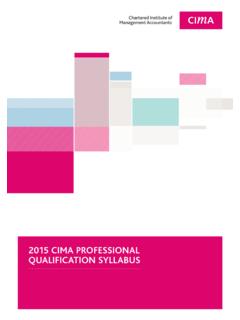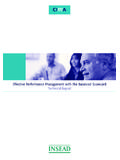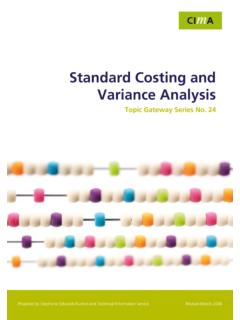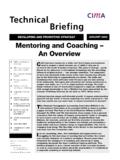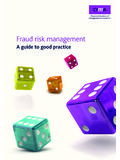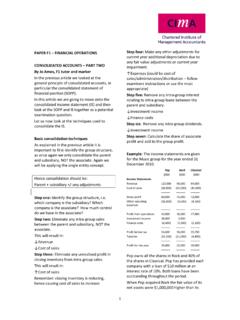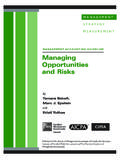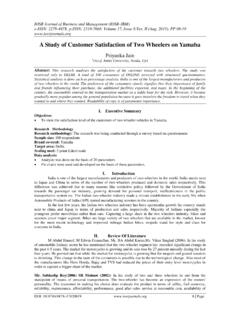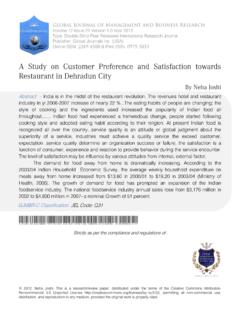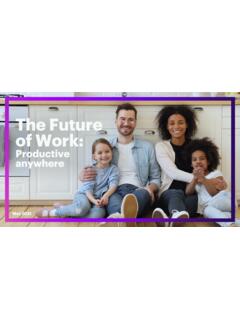Transcription of MANAGEMENT CASE STUDY PRACTICE EXAM ANSWERS
1 The Chartered Institute of MANAGEMENT Accountants 2014 no reproduction without prior consent MANAGEMENT CASE STUDY PRACTICE EXAM ANSWERS The PRACTICE Exam can be viewed at Section 1 Report to the finance director Strategic implications of an increase in fuel prices and an evaluation of activity-based MANAGEMENT Fuel prices The price of aviation fuel continues to be volatile. The political situation in major oil exporting countries has caused a recent spike in prices. This paper discusses some of the implications of a prolonged increase.
2 Fuel accounts for = 25% of our cost per ASK (see pre-seen). That suggests that a prolonged increase will prove costly to our operations. Given the central role of fuel prices in the industry, we can expect to see other airlines increasing ticket prices in response to this increase in cost. It may be that we can consider passing on the increased cost of airfares to customers because prices will be rising across the industry. Unfortunately, our position as a no-frills airline does not save us a significant amount in terms of fuel costs and so we may lose ground to the traditional airlines.
3 For example, National Air s fuel cost is only = 19% of their cost per ASK. In other words, if we both pass on the same cost increase for fuel our fares will rise by a larger proportion than theirs and so we could lose some of our competitive position. Clearly, many of our customers are forced to buy airline tickets and so a price rise will leave a segment of the market unaffected. Unfortunately, there are also customers who have some discretion over whether to travel (or travel is a luxury). We can expect total demand to decline in the event of a price rise.
4 Again, that could erode some of our competitive advantage because running our aircraft at close to full capacity helps us to offer lower prices than our competitors. ABM and target costing Our use of ZBB (see pre-seen) and other techniques mean that we would have to do very little in order to move further towards the use of activity based MANAGEMENT and target costing. Arguably, we have used both techniques to a large extent albeit under a different heading. Activity based MANAGEMENT requires that we understand the cost of providing our service.
5 The biggest area in which we might explore that is by looking at our route network and the costs of operating from specific airports. Clearly, some routes will always be more profitable than others. Some airports charge higher landing fees and so the profitability of routes cannot be directly compared. These ANSWERS have been provided by CIMA for information purposes only. The ANSWERS created are indicative of a response that could be given by a good candidate. They are not to be considered exhaustive, and other appropriate relevant responses would receive credit.
6 CIMA will not accept challenges to these ANSWERS on the basis of academic judgement. MANAGEMENT Case STUDY PRACTICE Exam 2 2014 ABM would require us to STUDY costs and revenues closely with a view to making a decision as to whether we could utilise resources more effectively. For example, we should STUDY customers buying behaviour to establish whether we have routes that feed into other services. For example, some routes may appear to be relatively unprofitable but they stimulate demand because passengers then fly on to a final destination using Fly-jet.
7 Closing some routes may lead to a more significant loss of revenue when the onward connections are taken into account. ABM might also help us to understand the impact of some of the processes that we use. For example, the sale of inflight snacks is difficult to cost because we are using flight attendants who would be paid anyway, but they could lead to unseen costs, such as additional cleaning costs and potential delays when readying a plane for its next flight. Target costing would be useful because there are market forces that restrict our prices.
8 We are likely to find it difficult to sell tickets if our competitors undercut us. We must also offer some consistency in our pricing because our prices are visible on the website and customers may be concerned that prices are excessive if routes are priced differently for flights of a similar duration. To an extent, target costing is difficult because we cannot manage all costs. For example, engineering costs are difficult to reduce without compromising flight safety. We are also a victim of our own success because we have already cut many costs to the absolute minimum and have eliminated many of the discretionary costs that have been identified as avoidable.
9 It may be possible to introduce cost reductions by stealth, such as gradually increasing the selling prices of our inflight snack range or by selling more services such as premier seats. I hope that this report is helpful. Please contact me if you have any questions. 2014 3 MANAGEMENT Case STUDY PRACTICE Exam Report to the finance director Change MANAGEMENT and marketing issues Move to TQM TQM may prove threatening to our staff because our business model is essentially to keep costs to the bare minimum.
10 Improving on cost may lead to redundancy because staff costs are our second greatest component of cost per ASK and engineering is also labour intensive. TQM traditionally involves staff being involved in quality circles and similar activities. Our business makes that difficult because aircrew travel and are rarely able to meet with colleagues other than those in their aircraft. It may be possible to circumvent that by communicating through email or via teleconference. It may be difficult for us to fully understand our customers needs in this context.
